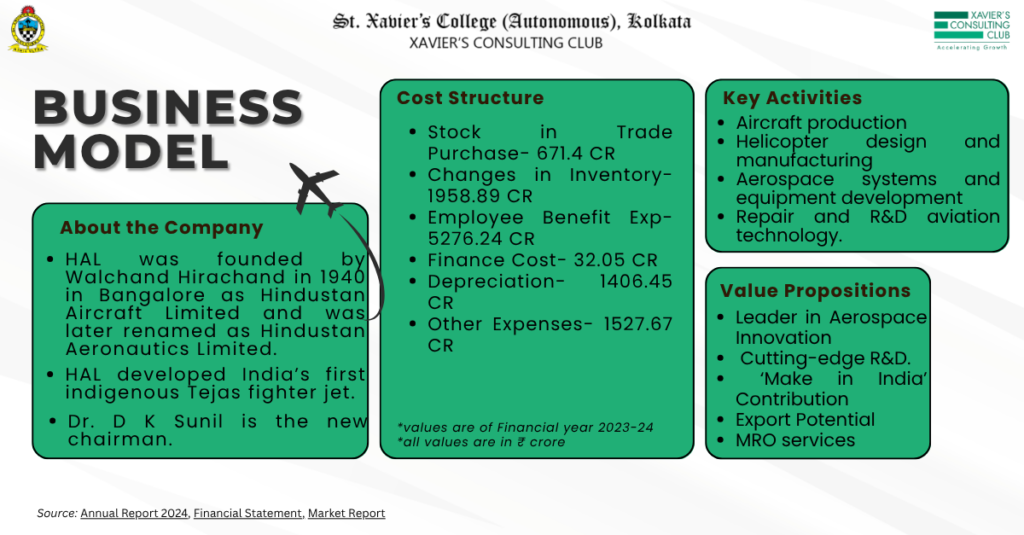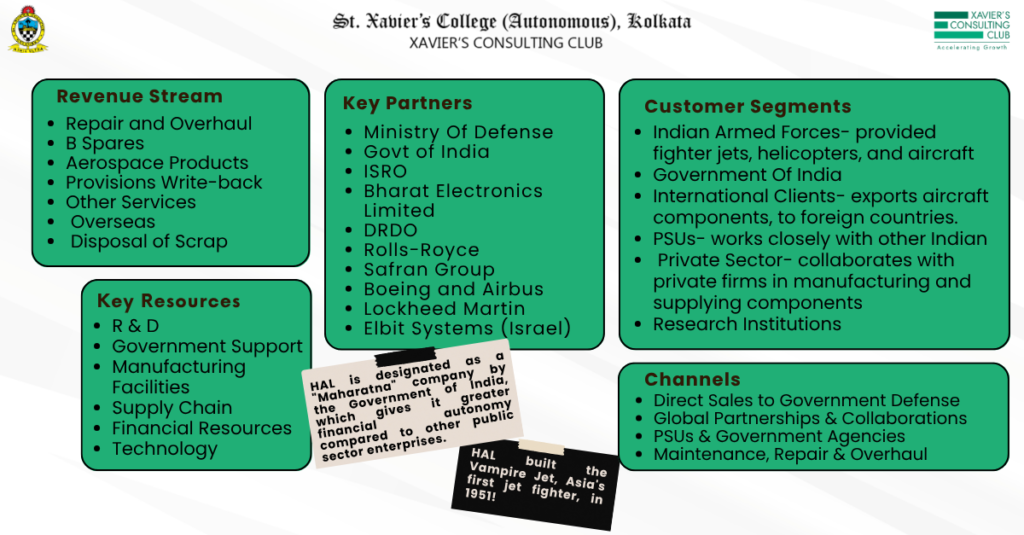

ABOUT THE COMPANY:
Hindustan Aeronautics Limited (HAL) is an Indian public-sector aerospace and defense company, headquartered in Bengaluru (Bangalore). Established on 23 December 1940, by Walchand Hirachand in in Bangalore as Hindustan Aircraft Limited and was later renamed Hindustan Aeronautics Limited. HAL is one of the oldest and largest aerospace and defense manufacturers in the world.HAL began aircraft manufacturing as early as 1942. During the 1980s, HAL’s operations saw a rapid increase which resulted in the development of new indigenous aircraft such as the HAL Tejas and HAL Dhruv. In October 2024, HAL was given Maharatna status, which allows the company to have more operational and financial autonomy.
COST STRUCTURE
EXPENSES (in CR.)
| Cost of Raw Materials | Purchases of Stock-in-Trade | Changes in Inventories | Employee Benefit Expenses | Finance Cost | Depreciation | Other Expenses |
| 12363.44 | 671.4 | 1958.89 | 5276.24 | 32.05 | 1406.45 | 1527.67 |
KEY ACTIVITIES
- Aircraft production (fighters, trainers, transport aircraft) like IJT, Hawk, HTT-40, Dornier, and LCA.
- Helicopter design and manufacturing include Dhruv , Rudra , LCH , LUH , Chetak , and Cheetah.
- Aerospace systems and equipment development.
- Repair and overhaul services.
- Research and development in defense aviation technology.
VALUE PROPOSITION
- Indigenous Aerospace Capabilities: Leading in the design, development, and manufacturing of aircraft, helicopters, and defense systems.
- Research and Innovation: Joint R&D projects with universities and research institutions foster aerospace technology advancements.
- ‘Make in India’ Contribution: Key player in boosting India’s self-reliance in aerospace and defense.
- Export Potential: Cost-effective, high-quality solutions for global markets.
- Comprehensive MRO Services: Maintenance, repair, and lifecycle support for defense equipment.
HAL REVENUE BREAK DOWN FOR FY 2023-24
HAL’s revenue for the last year amounted to 298.32 B INR, the most of which — 142.34 B INR — came from its highest performing source at the moment, Repair & Overhaul, the year earlier bringing 137.03 B INR.
| Particulars | Amount INR |
| Repair and Overhaul | 142.34 B |
| Spares | 59.15 B |
| Aerospace Products | 56.65 B |
| Provisions no longer required | 20.85 B |
| Development | 15.26 B |
| Miscellaneous | 7.72 B |
| Overseas | 1.05 B |
| Other Services | 488.30 M |
| Disposal of Scrap/ Unserviceable Stores | 121.80 M |
| Other | 169.90 M |
| Total | 298.32 B INR |
KEY RESOURCES
- Manufacturing Facilities : Facilities in Nashik, and Kanpur are equipped with advanced machinery for the production of fighter jets and aircrafts while facilities in Bengaluru and Barrackpore specialize in manufacturing helicopters like Dhruv and LCV.
- R & D Centers: Aeronautical Development Agency (ADA) and the Rotary Wing Research & Design Centre (RWR&DC).
- Maintenance, Repair, and Overhaul (MRO) and Testing Facilities: HAL’s MRO facilities ensure the longevity and optimal performance of the Indian Armed Forces. HAL works closely with certification authorities like the Center for Military Airworthiness and Certification (CEMILAC).
- Training Institutes: The company operates training centers such as the HAL Management Academy (HMA) and Technical Training Institutes (TTIs).
- Regulatory and Government Support: Strong backing from the Government of India provides policy support and alignment with national defense objectives. HAL plays a key role in government initiatives like “Make in India” and “Atmanirbhar Bharat”.
CONSUMER SEGMENT
Hindustan Aeronautics Limited (HAL) has a strong and diverse consumer relationship, primarily focused on the Indian defense sector. Its key consumers include:
- INDIAN ARMED FORCE’s largest customer, providing fighter jets, helicopters, and transport aircraft
- GOVERNMENT OF INDIA collaborates with various government ministries, especially the Ministry of Defence,
- INTERNATIONAL CLIENTS HAL exports aircraft components, spares, and helicopters to countries like Malaysia, Mauritius, Vietnam, and others.
- PUBLIC SECTOR UNITS (PSUs): HAL works closely with other Indian PSUs like BEL and BDL
- PRIVATE SECTOR: HAL collaborates with private firms in manufacturing and supplying components
- RESEARCH INSTITUTIONS: HAL works with organizations like DRDO (Defence Research and Development Organisation) and ISRO (Indian Space Research Organisation) for R&D and technology sharing.
HAL KEY PARTNERS
- Ministry Of Defence Govt of India
- Indian Space Research Organisation (ISRO)
- Bharat Electronics Limited (BEL)
- Defence Research and Development Organisation (DRDO)
- Rolls-Royce
- Safran Group
- Russian Companies (e.g., Sukhoi, MiG, United Aircraft Corporation)
- Boeing and Airbus
- Lockheed Martin
- Elbit Systems (Israel)
CHANNELS OF DISTRIBUTION
- Direct Sales to Government & Defense: Primary channel for selling aircraft, helicopters, and defense equipment to the Indian Armed Forces (Air Force, Navy, Army) and other government entities.
- Strategic Partnerships & Collaborations: Collaborations with global aerospace companies (e.g., Boeing, Lockheed Martin, Rolls-Royce) for joint ventures, technology transfers, and production.
- Public Sector Units & Government Agencies: Supply of parts and services to other government agencies like DRDO, ISRO, and Indian defense manufacturing units.
- Exports: International sales and supply of aircraft, helicopters, and aerospace systems to foreign governments and defense organizations.
- Maintenance, Repair & Overhaul (MRO): Service centers providing MRO services to both military and civil aviation clients.
KEY JOINT VENTURES CARRIED OUT BY HAL
| Name of Company | Purpose | Share Holding |
| BAeHAL Software Ltd. | Design, Develop & Market Computer Software, Firmware Programs and provide software solutions & service to the customers | HAL – 49% BAe Systems PLC, UK – 40%. BAeHAL Employees Welfare Trust, India -11% |
| Indo Avia Services Limited | Provide product support / spares for Russian / erstwhile Soviet Union origin fleet of aircraft by sourcing through its Russian partners. | Indian Firms HAL : 48% ICICI Bank : 5% Russian Firms RAC MiG : 31 % R yazan :10 % Aviazapchast: 6 % |
| Safran HAL Aircraft Engines Pvt. Ltd. | Centre of Excellence for production of Precision Aero engine components and assemblies as an Export Oriented Unit (EOU) | HAL :50% Safran Aircraft Engines, France: 50% |
| Samtel HAL Display System Ltd. | Design, Development and Manufacture of various types of display systems for Airborne, Military and ground applications for sale in India and International markets. | HAL : 40% Samtel Avionics Ltd.,India: 60% |
| HAL Edgewood Technologies Pvt. Ltd. | Development and manufacture of high technology miniature electronic modules and avionics systems for aerospace applications. | HAL :50% Edgewood Ventures, LLC, USA : 26% Edgewoodtechnologies Pvt. Ltd, India : 24% |
| HALBIT Avionics Pvt. Ltd. | Design, Development, marketing & maintenance of Simulators and Avionics products | HAL :50% Elbit Systems Ltd, Israel : 26% Merlin Hawk Associates Pvt. Ltd, India : 24% |
| Infotech HAL Limited | Design and Engineering services in the field of Aero-Engines and Technical Publications | HAL : 50% Cyient (Infotech), India : 50% |
KEY PARTNERS
1. Government Bodies
- Ministry of Defence (MoD): HAL operates under the aegis of the MoD, which is its primary customer and partner. Collaborations focus on defense procurement, funding for projects, and strategic defense initiatives.
- Bharat Electronics Limited (BEL) and other public sector enterprises: Joint projects often involve these organizations for integrated defense systems, ensuring a cohesive approach to national defense.
2. Defense Research Organizations
- Defence Research and Development Organisation (DRDO): HAL works closely with DRDO on various projects, including the development of indigenous fighter jets, advanced missile systems, and UAVs. This partnership facilitates the integration of cutting-edge technologies into HAL’s products.
- National Aerospace Laboratories (NAL): Collaborations focus on research in aerodynamics, materials, and aircraft design, contributing to innovative solutions in aerospace engineering.
3. Foreign Aerospace Companies
- Technology Partnerships: HAL partners with global aerospace companies such as Boeing, Airbus, and Lockheed Martin for technology transfer and collaborative projects. These partnerships help HAL access advanced technologies and enhance its manufacturing capabilities.
- Joint Ventures: Examples include collaborations with firms like Russian Helicopters for the production of helicopters and with international firms for developing advanced avionics and systems.
4. Academic Institutions
- Research Collaborations: HAL partners with prestigious institutions such as the Indian Institutes of Technology (IITs) and other universities for research projects. These collaborations aim to drive innovation in aerospace technologies and develop a skilled workforce.
- Internship and Training Programs: By engaging students and researchers, HAL benefits from fresh ideas and talent while contributing to the educational development of future aerospace engineers.
5. Suppliers and Vendors
- Component Manufacturers: HAL collaborates with a vast network of suppliers for critical components such as engines, avionics, and materials. This ensures high-quality production and timely delivery of aircraft and systems.
- Local and International Suppliers: Partnerships with both domestic and global suppliers help HAL diversify its supply chain, reduce costs, and enhance its operational efficiency.
6. Industry Associations
- Aerospace and Defence Suppliers Association (ADSA): HAL engages with industry bodies to promote collaboration among aerospace and defense manufacturers. This involvement helps shape industry standards, advocate for policies beneficial to the sector, and foster innovation.
- FICCI and CII: Partnerships with these organizations enable HAL to participate in discussions on policy-making, economic development, and industry trends.
STRATEGIC IMPLICATION
The diverse network of partners enables HAL to leverage external expertise, access advanced technologies, and maintain a competitive edge in both domestic and international markets. These collaborations are essential for:
- Technological Advancement: Continuous innovation through joint research and development.
- Operational Efficiency: Streamlined processes and shared resources with suppliers and partners.
- Market Expansion: Access to new markets through international partnerships and collaborations.
- Enhanced Product Offerings: Development of advanced and customized solutions for military and civil aviation needs.
FUTURE DIRECTIONS
As the aerospace sector evolves, HAL is likely to continue expanding its partnerships, particularly in emerging technologies such as unmanned aerial vehicles (UAVs), artificial intelligence, and advanced materials. These strategic alliances will be crucial in maintaining HAL’s leadership position in the aerospace industry and contributing to India’s defense capabilities.
KEY COMPETITORS
- Boeing (U.S.) : Boeing is one of the world’s leaders in the aerospace sector, and it also manufactures many military and commercial aircrafts. Its strength lies in highly advanced technology, especially in fighter jets, UAVs, and space exploration.
- Airbus (Europe): Airbus has always been popular with cutting-edge technologies in civilian aviation, particularly those underpinning its flagship models, such as the A320 and A350, and in military transport, using the A400M.
- Lockheed Martin (U.S.) : Lockheed Martin is a leader in defense industry primarily due to its manufacturing of military aircraft like the F-35 and the C-130, as well as amazing capabilities in missile systems and cyber security. The extensive research and development on advanced stealth technology and next-generation fighter jets serve to support these endeavors.
- Russian Helicopters (Russia): Russian Helicopters is the largest manufacturer of both military and civilian helicopters. The best-known models are Mi-17 and Ka-52. The company has a good reputation for focusing on rugged, all-terrain helicopter designs that can be used with excellent performance in challenging conditions.
- Dassault Aviation (France): Dassault Aviation is one of the finest companies that manufacture high-performance jet military aircraft – for example, the Rafale, which has gained fabulous renown for its precision and ability to execute a fight. The company receives considerable support from European and other world governments, mainly in the development of combat aircraft and luxury business jets, such as the Falcon series.
COMPETITIVE ADVANTAGE
- Cost-Effective Solutions – HAL is offering relatively affordable defense equipment and services, mainly for developing countries looking for cost-effective alternatives to the American or Western manufacturers.
- Regional Focus – HAL targets markets in Southeast Asia, Africa, and the Middle East, often offering tailored solutions for regional defense needs, where Western competitors may not focus as much.
- Diverse Portfolio – HAL has expertise in both military (Tejas, Light Combat Helicopter) and civil aviation(Do-228 , Dhruv AHL), allowing it to excel into both markets.
- Local expertise – Local know-how of HAL has so far given the company an ability to give cheap, customized, and deployable solutions helping developing countries where budgetary constraints, environmental issues, and operational requirements are the main factors. In the last few decades, the presence of HAL in India has helped this organization in building a very broad network of local suppliers and vendors that would reduce loads of expensive international supply chains on the organization.
- Indigenous Manufacturing and Technology Development – HAL has collaborations with Indian research institutions and universities, thereby enabling a steady inflow of innovations that are so critical to evolving new defense technologies. This helps them in creating local products that are cost-effective as well as have precise technological concerns.

